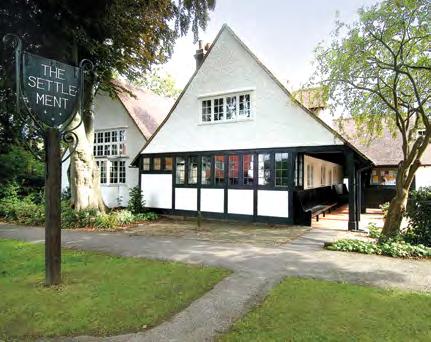
3 minute read
History All Around
While it’s the beautiful landmark buildings of the Garden City that initially catch the eye, scratch beneath the surface and discover Letchworth’s rich history from ancient churches to the UK’s first roundabout

Advertisement
Letchworth was originally one of three local villages, along with Willian and Norton, mentioned in the Domesday Book.
All Saints Church in Willian is a Grade II* Listed building with intricate gargoyles on the tower that has been serving its community for more than 900 years. The nearby St Mary the Virgin Church dates back to the 12th century while St Nicholas Church, Norton, features a Norman arch and bells which have rung for centuries.
New churches were added to these as the Garden City grew. Built as the meeting house for the Society of Friends (Quakers), Howgills Friends’ Meeting House has at its heart a grand wooden-panelled meeting room with an integral musicians’ gallery. It opened in 1907, and today Howgills is still a place of worship and home to a range of local organisations and activities.
Barry Parker designed the Letchworth Free Church in the centre of the town. Built in 1923, it has a more classical style than his earlier Arts and Crafts designs, and was the first church built in the new Garden City.
Howgills Friends’ Meeting House

Founding architects Parker and Unwin were passionate exponents of the Arts and Crafts movement, which celebrated traditional craftsmanship. Their legacy can be seen in the many different types of buildings around the town from imposing bespoke homes to lovingly crafted cottages. Getting up close really pays dividends as the creativity and care put into the design of small details of features like windows and doors is revealed. Shortly after the birth of the Garden City, Letchworth was home to two exhibitions of experimental housing in 1905 and 1907. Early pioneers of the Ideal Home shows, the exhibitions drew architects from across the country tasked with creating cottages of imaginative designs that cost no more than £150. Today 181, almost all of the Exhibition Cottages can still be seen.

Nearby is The Settlement, created as a temperance pub with no beer. Designed by Parker and Unwin and opened in 1907 as The Skittles Inn, the idea was fairly short-lived.
In 1925 it became an adult education centre, a role it continues to this day, offering courses in everything from fine art to upholstery, French to local history. It is also home to a small theatre company.
The town’s first public building was the Mrs Elizabeth Howard Memorial Hall. It was paid for by public subscription in memory of Ebenezer Howard’s first wife, who died in 1904, shortly after the First Garden City was inaugurated.
One of the town’s more unusual buildings is The Cloisters, designed in 1907 by Harrison Cowlishaw to fulfill a dream of philanthropist create an open-air school for the study of Psychology, it soon became base for a small community dedicated to the philosophy of Theosophy.
Today it is maintained as a Masonic centre and open to the public on selected days. It has been designated as one of the great historic buildings of the county.
A more unusual landmark is Sollershott Circus, which is not a building but the UK’s first ever roundabout. Positioned halfway Annie Lawrence. She wanted to
along the impressive Broadway, it was built in 1909 and was the first ‘gyratory traffic flow system’ when cars were in their infancy.
Perhaps the jewel in Letchworth’s architectural crown is the imposing Spirella Building, created between 1912 and 1920 for the eponymous corset company. Architect Cecil Hignett was commissioned to design a state-of-the art factory of great beauty, which is a testament to the enlightened employers the town attracted.
Nothing was too good for the company’s ‘Healthy Happy Workers’ with a ballroom, now lovingly restored, provided for employees to dance and socialise, as well as a gym and baths. Today this Grade II* Listed building is home to offices, hosts weddings and the magnificent ballroom is available for private hire.
It is a shining example of the combination of ambition and altruism that continues to be Letchworth’s hallmark.











